A Wideband Circularly Polarized Dipole Antenna with Compact Size and Low-Pass Filtering Response
Abstract
:1. Introduction
2. Antenna Structure and Design Procedure
2.1. Antenna Structure
2.2. Design Procedure
2.3. Low-Pass Filtering Radiation Response
3. Antenna Implementation
4. Conclusions
Author Contributions
Funding
Institutional Review Board Statement
Informed Consent Statement
Data Availability Statement
Conflicts of Interest
Abbreviations
| CP | Circularly Polarized Antenna |
| AR | Axial Ratio |
| HPBW | Half-Power Beamwidth |
| RHCP | Right-Hand Circularly Polarized |
| LHCP | Left-Hand Circularly Polarized |
| MIMO | Multi-Input Multi-Output |
References
- Gao, S.S.; Luo, Q.; Zhu, F. Introduction to Circularly Polarized Antennas. In Circularly Polarized Antennas; John Wiley & Sons: Hoboken, NJ, USA, 2014; pp. 1–28. [Google Scholar] [CrossRef]
- Yang, W.J.; Pan, Y.M.; Zheng, S.Y. Mutual Coupling Reduction in CP MIMO Crossed-Dipole Antenna Array. IEEE Antennas Wirel. Propag. Lett. 2022, 21, 2442–2446. [Google Scholar] [CrossRef]
- Saurav, K.; Sarkar, D.; Srivastava, K.V. Dual-Band Circularly Polarized Cavity-Backed Crossed-Dipole Antennas. IEEE Antennas Wirel. Propag. Lett. 2015, 14, 52–55. [Google Scholar] [CrossRef]
- He, Y.; He, W.; Wong, H. A Wideband Circularly Polarized Cross-Dipole Antenna. IEEE Antennas Wirel. Propag. Lett. 2014, 13, 67–70. [Google Scholar] [CrossRef]
- Tu, Z.H.; Jia, K.G.; Liu, Y.Y. A Differentially Fed Wideband Circularly Polarized Antenna. IEEE Antennas Wirel. Propag. Lett. 2018, 17, 861–864. [Google Scholar] [CrossRef]
- Feng, G.; Chen, L.; Wang, X.; Xue, X.; Shi, X. Broadband Circularly Polarized Crossed Bowtie Dipole Antenna Loaded with Parasitic Elements. IEEE Antennas Wirel. Propag. Lett. 2018, 17, 114–117. [Google Scholar] [CrossRef]
- Feng, Y.; Li, J.; Cao, B.; Liu, J.; Yang, G.; Wei, D.J. Cavity-Backed Broadband Circularly Polarized Cross-Dipole Antenna. IEEE Antennas Wirel. Propag. Lett. 2019, 18, 2681–2685. [Google Scholar] [CrossRef]
- Wang, H.; Byun, G.; Park, Y.B.; Park, I. Circularly Polarized Wideband Uniplanar Crossed-Dipole Antenna with Folded Striplines and Rectangular Stubs. IEEE Access 2023, 11, 63252–63260. [Google Scholar] [CrossRef]
- Wang, L.; Fang, W.X.; Shao, W.H.; Yao, B.; Huang, Y.; En, Y.F. Broadband Circularly Polarized Cross-Dipole Antenna with Multiple Modes. IEEE Access 2020, 8, 66489–66494. [Google Scholar] [CrossRef]
- Sefidi, M.; Ghobadi, C.; Nourinia, J.; Naderali, R. Broadband Circularly Polarized Printed Crossed-Dipole Antenna and Its Arrays for Cellular Base Stations. IEEE Access 2024, 12, 6842–6851. [Google Scholar] [CrossRef]
- Mak, K.M.; Luk, K.M. A Circularly Polarized Antenna with Wide Axial Ratio Beamwidth. IEEE Trans. Antennas Propag. 2009, 57, 3309–3312. [Google Scholar] [CrossRef]
- Ta, S.X.; Choo, H.; Park, I.; Ziolkowski, R.W. Multi-Band, Wide-Beam, Circularly Polarized, Crossed, Asy mmetrically Barbed Dipole Antennas for GPS Applications. IEEE Trans. Antennas Propag. 2013, 61, 5771–5775. [Google Scholar] [CrossRef]
- Wen, L.; Gao, S.; Luo, Q.; Hu, W.; Sanz-Izquierdo, B.; Yang, X.X. Wideband Circularly Polarized Reflectarray Antenna Using Rotational Sy mmetrical Crossed Dipoles. IEEE Trans. Antennas Propag. 2023, 71, 4576–4581. [Google Scholar] [CrossRef]
- Tran, H.H.; Ta, S.X.; Park, I. A Compact Circularly Polarized Crossed-Dipole Antenna for an RFID Tag. IEEE Antennas Wirel. Propag. Lett. 2015, 14, 674–677. [Google Scholar] [CrossRef]
- Lin, Y.F.; Wang, Y.K.; Chen, H.M.; Yang, Z.Z. Circularly Polarized Crossed Dipole Antenna with Phase Delay Lines for RFID Handheld Reader. IEEE Trans. Antennas Propag. 2012, 60, 1221–1227. [Google Scholar] [CrossRef]
- Kedze, K.E.; Wang, H.; Kim, Y.; Park, I. Design of a Reduced-Size Crossed-Dipole Antenna. IEEE Trans. Antennas Propag. 2021, 69, 689–697. [Google Scholar] [CrossRef]
- Xue, F.; Zhang, Y.; Li, J.; Liu, H. Circularly Polarized Cross-Dipole Antenna for UHF RFID Readers Applicated in the Warehouse Environment. IEEE Access 2023, 11, 38657–38664. [Google Scholar] [CrossRef]
- Xu, R.; Liu, J.; Wei, K.; Hu, W.; Xing, Z.J.; Li, J.Y.; Gao, S.S. Dual-Band Circularly Polarized Antenna with Two Pairs of Crossed-Dipoles for RFID Reader. IEEE Trans. Antennas Propag. 2021, 69, 8194–8203. [Google Scholar] [CrossRef]
- Inserra, D.; Wen, G. Compact Crossed Dipole Antenna with Meandered Series Power Divider for UHF RFID Tag and Handheld Reader Devices. IEEE Trans. Antennas Propag. 2019, 67, 4195–4199. [Google Scholar] [CrossRef]
- Wen, L.; Gao, S.; Sanz-Izquierdo, B.; Wang, C.; Hu, W.; Ren, X.; Wu, J. Compact and Wideband Crossed Dipole Antenna Using Coupling Stub for Circular Polarization. IEEE Trans. Antennas Propag. 2022, 70, 27–34. [Google Scholar] [CrossRef]
- Li, G.; Zhang, F.S. A Compact Broadband and Wide Beam Circularly Polarized Antenna with Shorted Vertical Plates. IEEE Access 2019, 7, 90916–90921. [Google Scholar] [CrossRef]
- Li, L.; Zhang, C.; Shao, Y.; Luo, J. An SIW-Fed Cross-Dipole Antenna with Broadband Circular Polarization for mmW Applications. IEEE Trans. Antennas Propag. 2022, 70, 4830–4835. [Google Scholar] [CrossRef]
- Ta, S.X.; Park, I. Dual-Band Low-Profile Crossed Asy mmetric Dipole Antenna on Dual-Band AMC Surface. IEEE Antennas Wirel. Propag. Lett. 2014, 13, 587–590. [Google Scholar] [CrossRef]
- Tran, H.H.; Park, I. A Dual-Wideband Circularly Polarized Antenna Using an Artificial Magnetic Conductor. IEEE Antennas Wirel. Propag. Lett. 2016, 15, 950–953. [Google Scholar] [CrossRef]
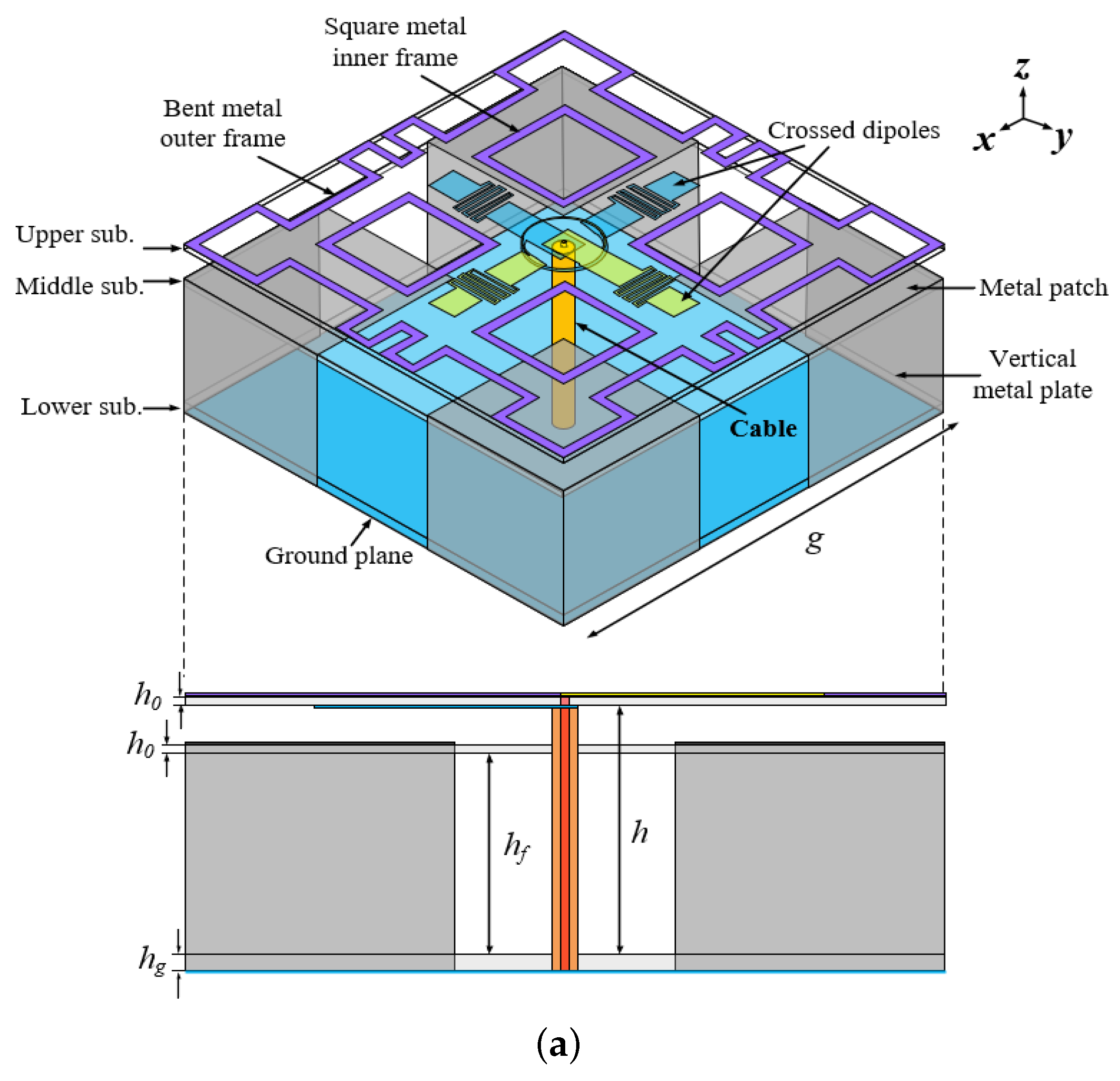



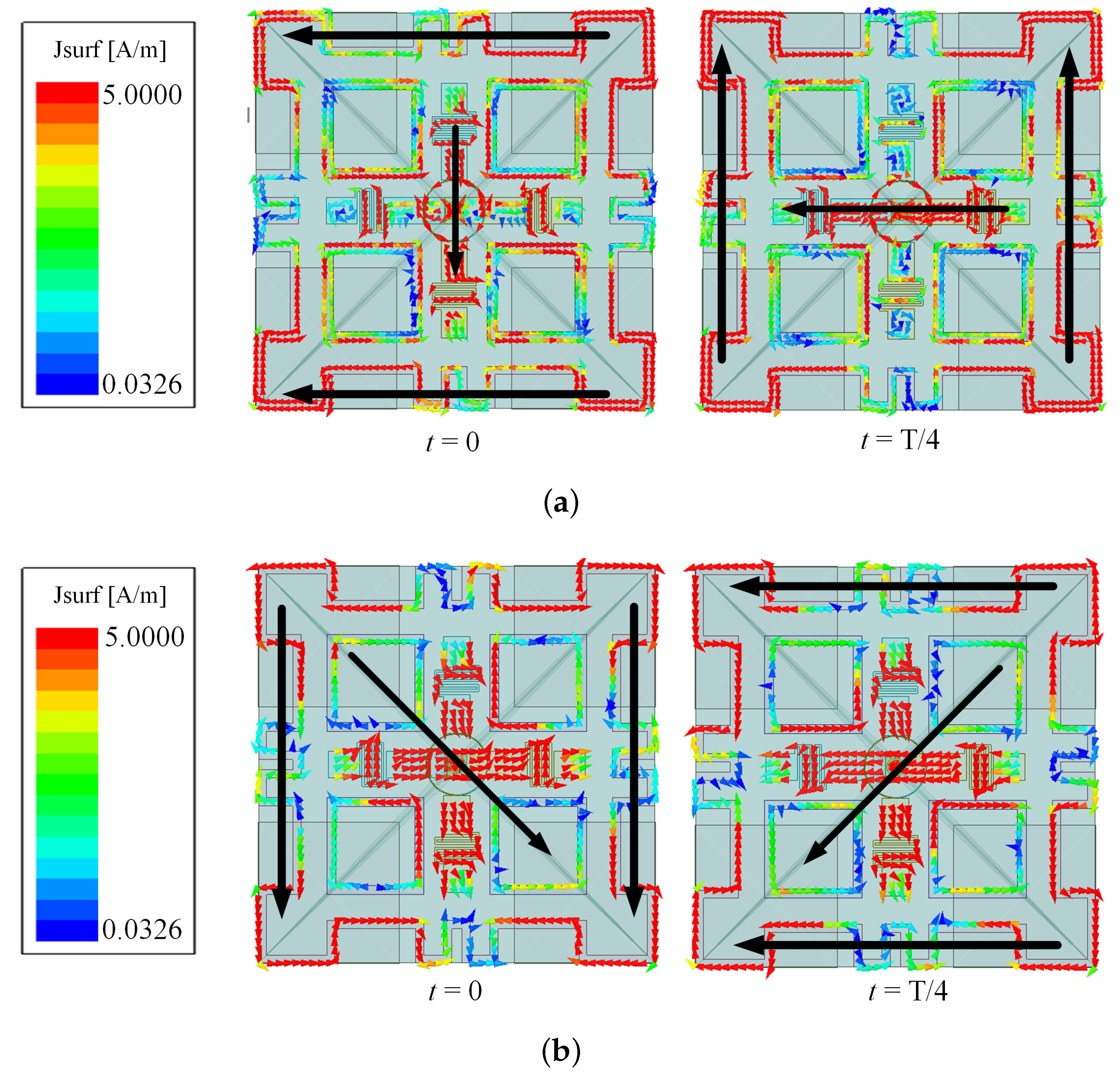
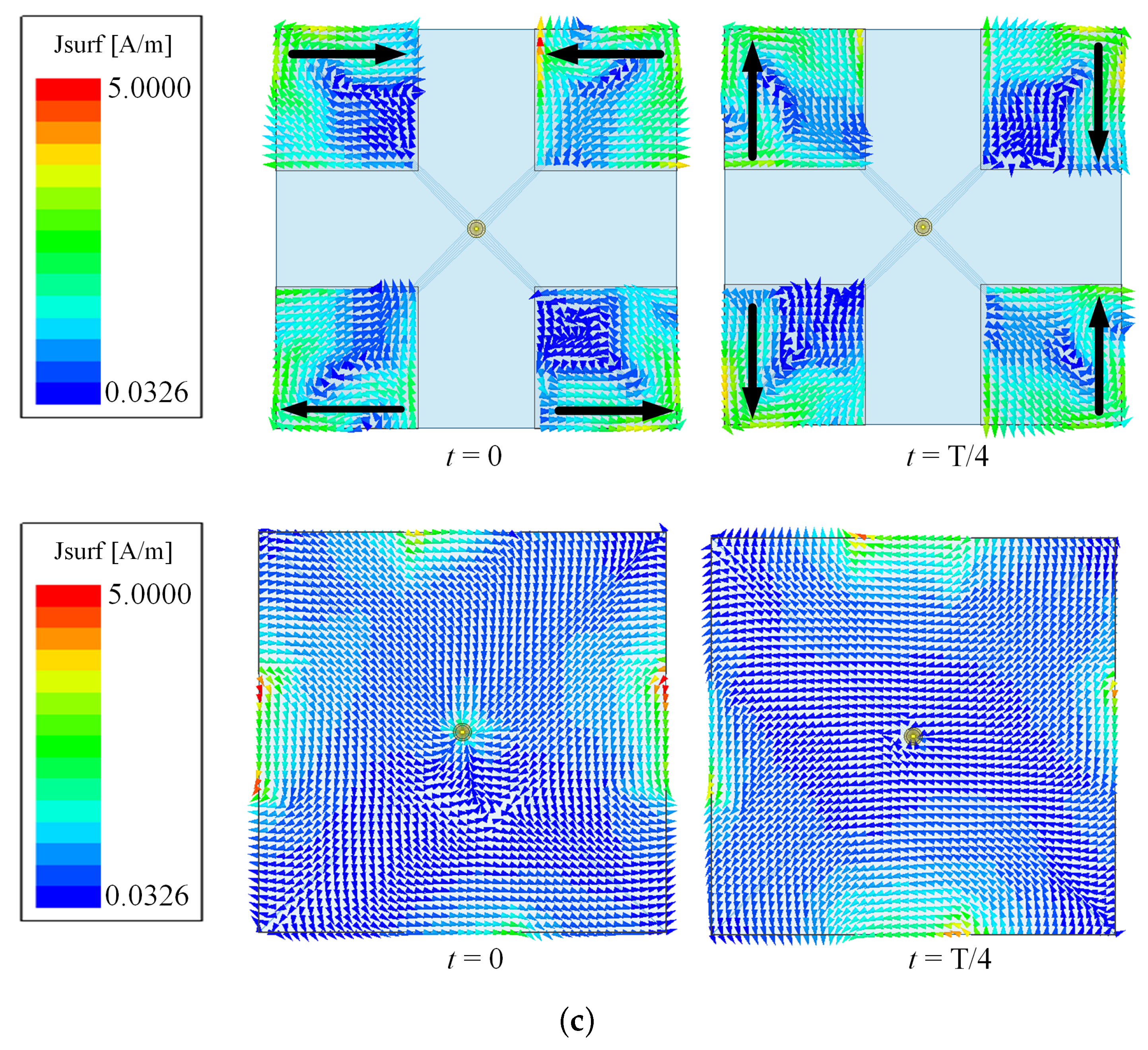


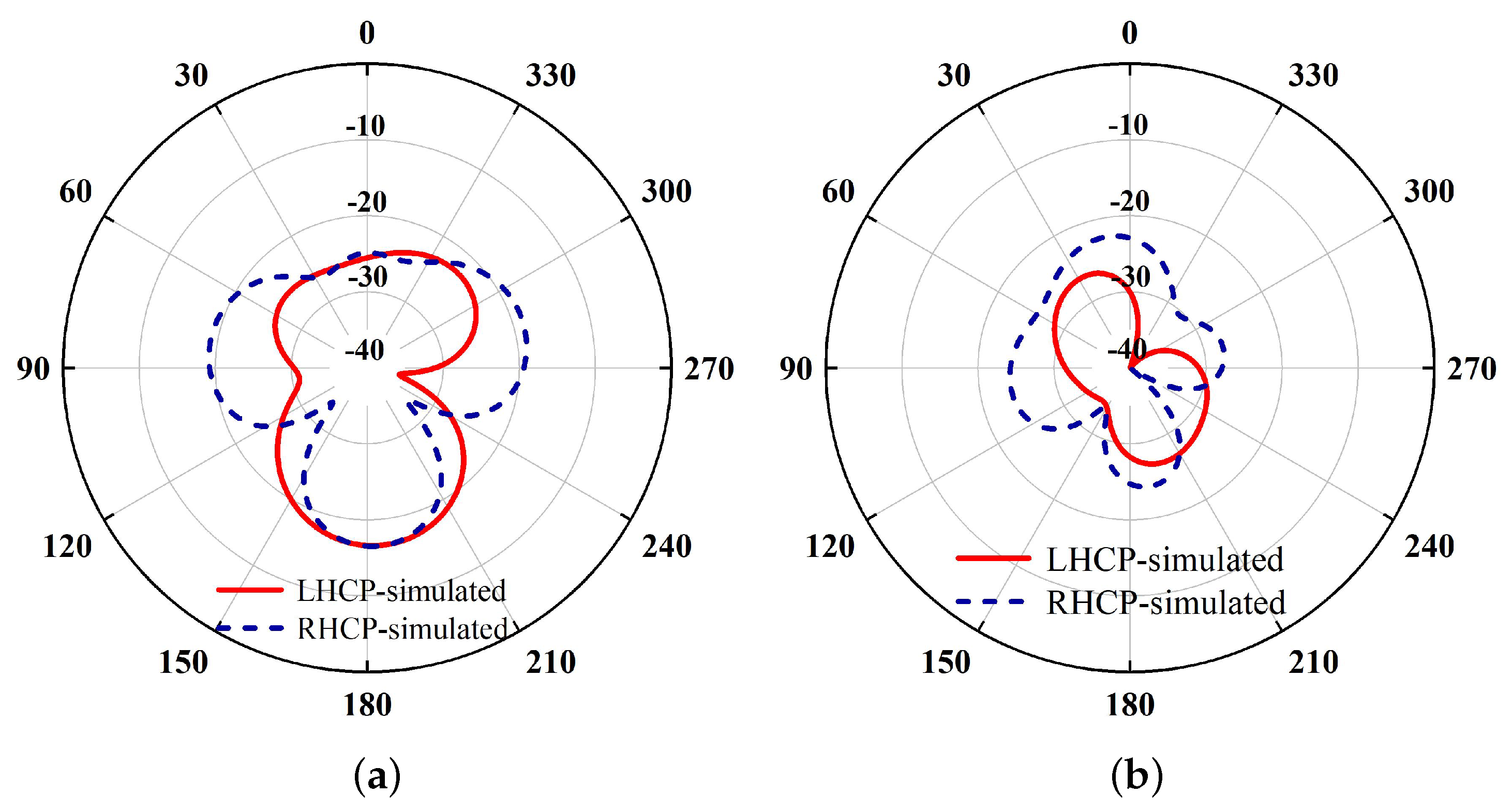

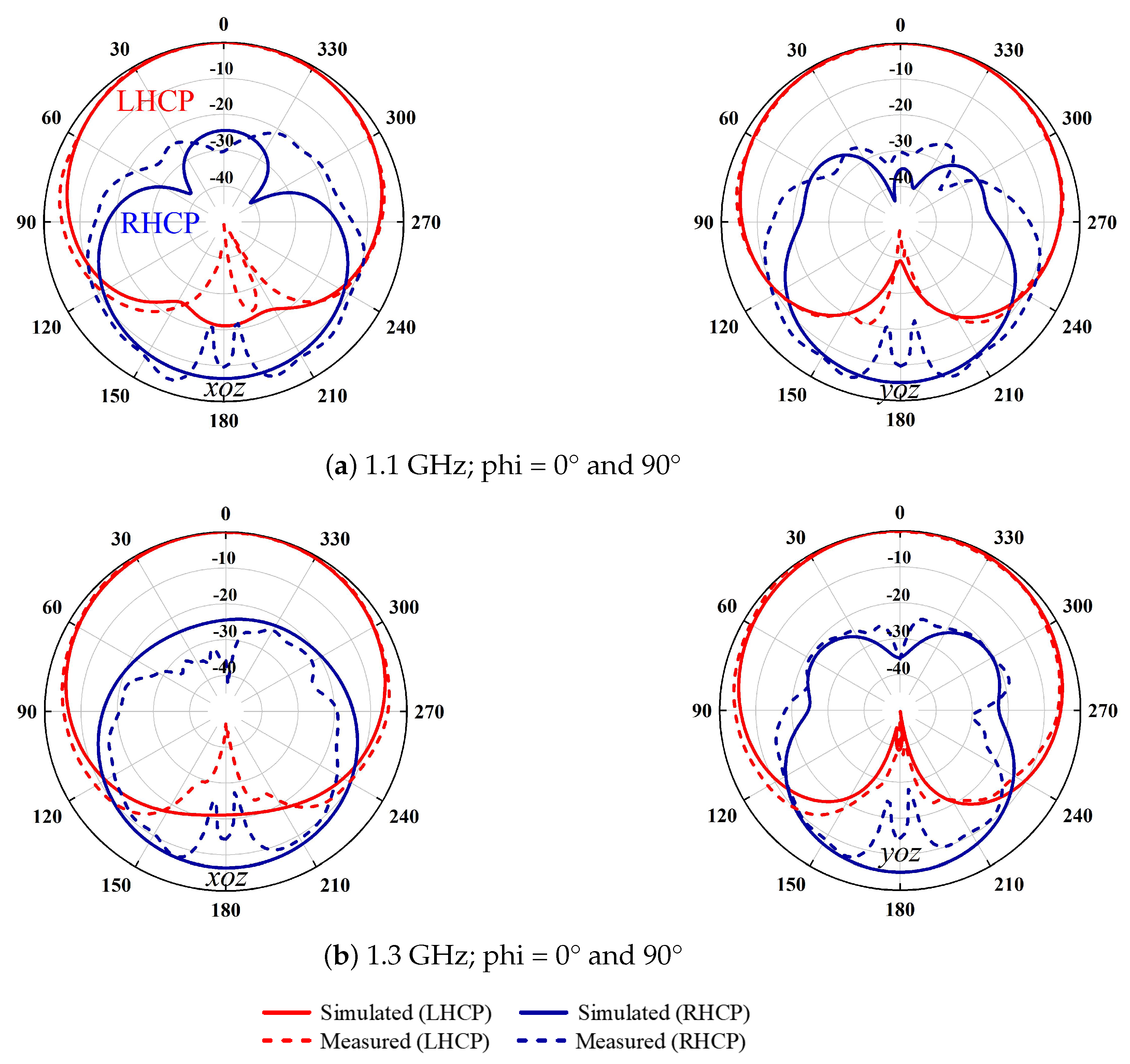
| Size () | Height () | Imp./AR BW (%) | Gain (dBic) | Rad. Null | HPBW | |
|---|---|---|---|---|---|---|
| [5] | 0.5 × 0.5 | 0.25 | 60.5/31 | 6.1–6.9 | No | 68° |
| [6] | 1.1 × 1.1 | 0.4 | 93.1/90.9 | −2–8.6 | No | N.A |
| [7] | 0.6 × 0.6 | 0.21 | 98.2/85.5 | 4.5–10 | No | N.A |
| [8] | 0.6 × 0.6 | 0.0027 | 55.26/53.5 | 1.8–2.08 | No | N.A |
| [9] | 1.0 × 1.0 | 0.26 | 95.5/94.4 | 0–7 | No | N.A |
| [10] | 1.1 × 1.1 | 0.25 | 57/33 | 7.8–8.7 | No | 65° |
| [16] | 0.2 × 0.3 | 0.0055 | 16.4/11.7 | 0.5–1.9 | No | 116° |
| [17] | 0.5 × 0.5 | 0.3 | 40/7.3 | 5–6.3 | No | 104° |
| [18] | 0.3 × 0.3 | 0.25 | 35.5/10.7 | 2.5–4.6 | No | N.A |
| [19] | 1.7 × 1.7 | 0.012 | 14.4/2.8 | 1.2–1.4 | No | N.A |
| [20] | 0.3 × 0.3 | 0.23 | 53.5/45 | 7.6–8.4 | No | 71° |
| [21] | 0.4 × 0.4 | 0.15 | 92.6/71.8 | −2.5–3.5 | No | 120° |
| [22] | 2.4 × 0.7 | 0.16 | 34.6/23.1 | 5–8.8 | No | N.A |
| [24] | 0.6 × 0.6 | 0.16 | 40/19.3 49.5/33.8 | 4–6 4–8 | No | N.A |
| This work | 0.37 × 0.37 | 0.14 | 53.3/41 | 3.5–4 | Yes | 120° |
Disclaimer/Publisher’s Note: The statements, opinions and data contained in all publications are solely those of the individual author(s) and contributor(s) and not of MDPI and/or the editor(s). MDPI and/or the editor(s) disclaim responsibility for any injury to people or property resulting from any ideas, methods, instructions or products referred to in the content. |
© 2024 by the authors. Licensee MDPI, Basel, Switzerland. This article is an open access article distributed under the terms and conditions of the Creative Commons Attribution (CC BY) license (https://creativecommons.org/licenses/by/4.0/).
Share and Cite
Lin, X.; Weng, Z.; Hong, Y.; Zhang, Y. A Wideband Circularly Polarized Dipole Antenna with Compact Size and Low-Pass Filtering Response. Sensors 2024, 24, 3914. https://doi.org/10.3390/s24123914
Lin X, Weng Z, Hong Y, Zhang Y. A Wideband Circularly Polarized Dipole Antenna with Compact Size and Low-Pass Filtering Response. Sensors. 2024; 24(12):3914. https://doi.org/10.3390/s24123914
Chicago/Turabian StyleLin, Xianjing, Zhangrun Weng, Yibin Hong, and Yao Zhang. 2024. "A Wideband Circularly Polarized Dipole Antenna with Compact Size and Low-Pass Filtering Response" Sensors 24, no. 12: 3914. https://doi.org/10.3390/s24123914






